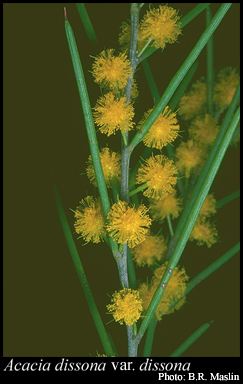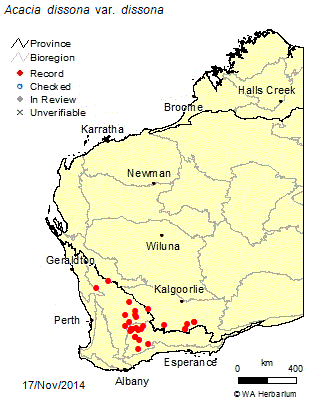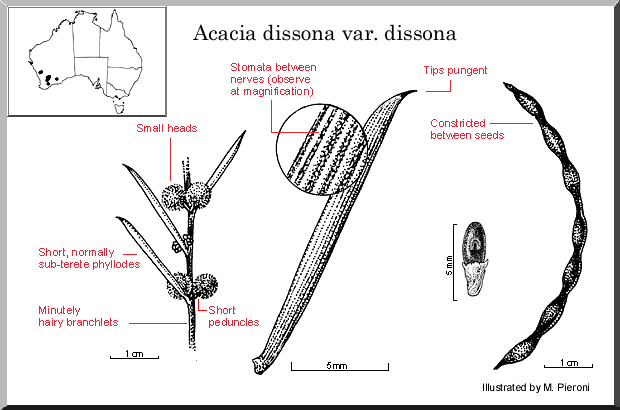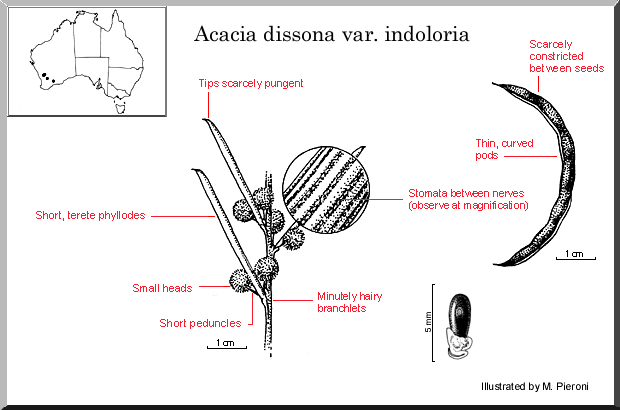Difference between revisions of "Acacia dissona"
(→References) |
(→General Plant Info) |
||
| (2 intermediate revisions by 2 users not shown) | |||
| Line 1: | Line 1: | ||
== General Plant Info == | == General Plant Info == | ||
| − | [[File:16119ic1.jpg|right| | + | [[File:16119ic1.jpg|right|250px]] |
Shrub 0.5–2 m high; branches often contorted. Branchlets ridged, appressed-puberulous. Phyllodes inclined to erect, straight, subterete or terete, 2–4 cm long, 1–1.5 mm wide, rather abruptly narrowed to a sharply pungent or mucronate to mucronulate tip, rigid, glabrous or pulvinus often puberulous adaxially, with numerous closely parallel, raised nerves that are sometimes paler than internerve spaces; stomata evident in internerve spaces; gland small; pulvinus normally slightly expanded at base. Inflorescences simple, 2 per axil; peduncles mostly 2–4 mm long, glabrous; heads globular, 5–6 mm diam. (fresh), 3–4 mm diam. (dry), 15–20-flowered, golden. Flowers 5-merous; sepals free. Pods linear, raised over and constricted between seeds, moderately curved, to 6 cm long and 2.5 mm wide, thin-crustaceous or thin-coriaceous, appressed-puberulous. Seeds longitudinal, oblong-elliptic, 2.5–4.5 mm long, 1.5 mm wide, glossy, dark brown; aril terminal, conical or broadly rounded and crested, pale yellow.<ref>Cowan, R.S., & Maslin, B.R. (1998). Nuystia, ''WESTERN AUSTRALIA’S JOURNAL OF SYSTEMATIC BOTANY'', 10(2), 210. Retrived from: http://florabase.dpaw.wa.gov.au/science/nuytsia/232.pdf</ref> | Shrub 0.5–2 m high; branches often contorted. Branchlets ridged, appressed-puberulous. Phyllodes inclined to erect, straight, subterete or terete, 2–4 cm long, 1–1.5 mm wide, rather abruptly narrowed to a sharply pungent or mucronate to mucronulate tip, rigid, glabrous or pulvinus often puberulous adaxially, with numerous closely parallel, raised nerves that are sometimes paler than internerve spaces; stomata evident in internerve spaces; gland small; pulvinus normally slightly expanded at base. Inflorescences simple, 2 per axil; peduncles mostly 2–4 mm long, glabrous; heads globular, 5–6 mm diam. (fresh), 3–4 mm diam. (dry), 15–20-flowered, golden. Flowers 5-merous; sepals free. Pods linear, raised over and constricted between seeds, moderately curved, to 6 cm long and 2.5 mm wide, thin-crustaceous or thin-coriaceous, appressed-puberulous. Seeds longitudinal, oblong-elliptic, 2.5–4.5 mm long, 1.5 mm wide, glossy, dark brown; aril terminal, conical or broadly rounded and crested, pale yellow.<ref>Cowan, R.S., & Maslin, B.R. (1998). Nuystia, ''WESTERN AUSTRALIA’S JOURNAL OF SYSTEMATIC BOTANY'', 10(2), 210. Retrived from: http://florabase.dpaw.wa.gov.au/science/nuytsia/232.pdf</ref> | ||
| + | |||
| + | |||
| + | |||
| + | Consists of 2 variants: | ||
| + | |||
| + | [[Acacia dissona var. dissona]] | ||
| + | |||
| + | [[Acacia dissona var. indoloria]] | ||
===Flowering=== | ===Flowering=== | ||
Latest revision as of 10:03, 15 February 2015
Contents
General Plant Info
Shrub 0.5–2 m high; branches often contorted. Branchlets ridged, appressed-puberulous. Phyllodes inclined to erect, straight, subterete or terete, 2–4 cm long, 1–1.5 mm wide, rather abruptly narrowed to a sharply pungent or mucronate to mucronulate tip, rigid, glabrous or pulvinus often puberulous adaxially, with numerous closely parallel, raised nerves that are sometimes paler than internerve spaces; stomata evident in internerve spaces; gland small; pulvinus normally slightly expanded at base. Inflorescences simple, 2 per axil; peduncles mostly 2–4 mm long, glabrous; heads globular, 5–6 mm diam. (fresh), 3–4 mm diam. (dry), 15–20-flowered, golden. Flowers 5-merous; sepals free. Pods linear, raised over and constricted between seeds, moderately curved, to 6 cm long and 2.5 mm wide, thin-crustaceous or thin-coriaceous, appressed-puberulous. Seeds longitudinal, oblong-elliptic, 2.5–4.5 mm long, 1.5 mm wide, glossy, dark brown; aril terminal, conical or broadly rounded and crested, pale yellow.[1]
Consists of 2 variants:
Flowering
Most flowering specimens have been collected in September and October, but the northern ones (from the Coorow-Wanarra area) were collected in July and August. Pods with mature seeds have been collected in December.
Phyllodes
2-4 cm long, sub-terete, contracted to short, more or less sharply pungent tips, nerves and inter-nerve spaces uniform in colour, stomata sometimes tuberculate.
Peduncles
2-5 mm long.
Pods
distinctly constricted between the seeds, sparingly appressed-puberulous
Geographic distribution
Discontinuous in southwest Western Australia in the Merredin-Southern Cross area south to near Ongerup with outliers in the Coorow-Wanarra area (c. 250 km northwest of Merredin) and in the Norseman area (c. 350 km northeast of Ongerup).
Identification
Comprises two closely related varieties:
Acacia dissona var. dissona
Phyllodes subterete, 2–4 cm long, contracted to sharply pungent apex; nerves and internerve spaces often uniform in colour; stomata sometimes tuberculate. Pods distinctly constricted between the seeds, sparingly appressed-puberulous. Seeds 4.5 mm long; aril long-conical.
Disjunct, occurring from Merredin- Southern Cross S to near Ongerup with outliers in the Coorow-Wanarra area (c. 250 km due NW of Merredin) and the Norseman area (c. 350 km due NE of Ongerup). Grows in a variety of soils, often clay, in eucalypt woodland and mallee.
Acacia dissona var. indoloria
Phyllodes terete, mucronate to mucronulate, innocuous to coarsely pungent; nerves paler than internerve spaces in mature phyllodes. Pods scarcely constricted between seeds, sparsely appressed-puberulous, at least between seeds. Seeds 2.5–3.5 mm long, with a broadly obtuse, crested aril.
Disjunct, occurring at Ballidu- Mollerin (c. 75- 145 km due E of Moora), Bruce Rock- Muntadgin (Muntadgin is c. 45 km due NE of Bruce Rock) and Frank Hann Natl Park (located 30- 110 km ENE of Lake King). Grows in sand, sandy loam and loam, mostly in open mallee.
The differences separating the two varieties comprising this species are indicated in the key. They are obviously closely related, with most of the differences in the pods and seeds.
Also resembles Acacia kalgoorliensis which has longer phyllodes with protracted, long-spinose tips.
Alkaloid content
Other uses
Extraction
Cultivation
Grows on clay, loam, and sandy soils in eucalypt woodland or mallee, sometimes dominated by Eucalyptus salmonophloia.
Suppliers
Links
References
- ↑ Cowan, R.S., & Maslin, B.R. (1998). Nuystia, WESTERN AUSTRALIA’S JOURNAL OF SYSTEMATIC BOTANY, 10(2), 210. Retrived from: http://florabase.dpaw.wa.gov.au/science/nuytsia/232.pdf
World Wide Wattle, Acacia dissona. Retrieved from:http://www.worldwidewattle.com/speciesgallery/dissona.php FloraBase, Acacia dissona R.S.Cowan & Maslin var. dissona. Retrieved from: http://florabase.dpaw.wa.gov.au/browse/profile/16119



